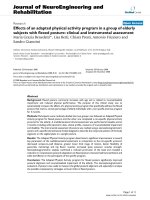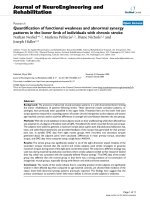Báo cáo hóa học: " Fabrication of functional micro- and nanoneedle electrodes using a carbon nanotube template and electrodeposition" ppt
Bạn đang xem bản rút gọn của tài liệu. Xem và tải ngay bản đầy đủ của tài liệu tại đây (2.42 MB, 6 trang )
NANO EXPRESS Open Access
Fabrication of functional micro- and nanoneedle
electrodes using a carbon nanotube template
and electrodeposition
Taechang An
1
, WooSeok Choi
1
, Eunjoo Lee
2
, In-tae Kim
1
, Wonkyu Moon
1
and Geunbae Lim
1,3*
Abstract
Carbon nanotube (CNT) is an attractive material for needle-like conducting electrodes because it has high electrical
conductivity and mechanical strength. However, CNTs cannot provide the desired properties in certain applications.
To obtain micro- and nanoneedles having the desired properties, it is necessary to fabricate functional needles
using various other materials. In this study, functional micro- and nanoneedle electrodes were fabricated using a
tungsten tip and an atom ic force microscope probe with a CNT needle template and electrodeposition. To prepare
the conductive needle templates, a single-wall nanotube nanoneedle was attached onto the conductive tip using
dielectrophoresis and surface tension. Through electrodeposition, Au, Ni, and polypyrrole were each coated
successfully onto CNT nanoneedle electrodes to obtain the desired properties.
Introduction
With the development of nanotechnology, the demand
for information about microscale systems has increased
[1,2]. Micro- and nanoneedle electrodes provide oppor-
tunities for electrochemical and biologica l studies of
microenvironments, such as scanni ng electrochemical
microscopy (SECM) [3-5] and single-cell analysis [6-8].
For example, a nanoneedle with a hig h aspect ratio and
small d iameter can be used as both an inject ion [9] and
manipulation tool [6,10] for biomolecules and nanopar-
ticles in a living cell. A nanoneedle with a functional
surface, such as metal oxide, can be used as an intracel-
lular sensor to monitor an intracellular e nvironment
[11]. Furthermore, a na noneedle electrode coated with
an insulation layer can be used as an SECM probe to
measure electrochemical reactions of micro- and
nanoenvironments [3,12].
To be used in various applications, a nanoneedle sur-
face must be modified to the desired functional surface.
Two methods are used to functionalize nanoneedles:
direct functionalization of the nanonee dle bare surface,
and functionalization of a nanoneedle surface coated
with other materials [13]. Because the bare surface of
nanoneedle materials provides only limited chemical
functional groups, complex chemical and p hysical treat-
ments are often used to obtain the desired surface prop-
erties. On the other hand, the surface coating method
not only a ffords the desired functional surface, but also
improves the mechanical properties of the nanoneedles.
Although many nanoneedle fabrication methods have
been re ported, these methods hav e material limitations
because most nanoneedles are fabri cated using carbon
nanotubes (CNTs) [7,14,15] and sil icon [6,16]. There-
fore, it is necessary to fabricate nanoneedles using var-
ious other materials to ensure their effective surface
functionalization. Electrodeposition is very useful for
fabricating functional nanoneedles because various
materials, such as metal [17], metal oxide [18], and poly-
mer [19], can be coated onto the desired location of the
conducting nanoneedle. Herein, we report a fabrication
method for functional micro- and nanoneedles using a
template of CNT nanoneedle and electrodeposition.
Experimental method
First, CNT na noneedles were fa bricated with a tungsten
tip and an AFM ti p using dielectrophoresis (DEP) and
surface tension [8,20]. The tungsten tips, with tip ends
of approximately 1 μm, were fabricated by electrolysis.
Single-wall nanotubes (SWNTs), manufactured via an
arc discharge process with a diameter of 1.0 to 1.2 nm
* Correspondence:
1
Department of Mechanical Engineering, Pohang University of Science and
Technology (POSTECH), Pohang, Korea.
Full list of author information is available at the end of the article
An et al . Nanoscale Research Letters 2011, 6:306
/>© 2011 An et al; licensee Springer. This is an Open Access article distributed under the terms of the Creative Commons Attribution
License ( which permits unrestricted use, distribution, and reproduction in any medium,
provided the original work is properly cited.
and length 5 to 20 μm, were purchased from Hanwha
Nanotech (Incheon, Korea). The SWNT suspension was
prepared by sonicating a mixture of 1-mg SWNT and
100 mL of 1 w t% sodium dodecylsu lfat e (SDS) solution
for 2 to 3 h, followed by centrifugation at 12,000 rpm
for 10 min to remove the undispersed SWNTs.
AsshowninFigure1a,twotungstentipswereplaced
a few micrometers apart, and an AC el ectric field of
1 MHz frequency and 10-V
p-p
amplitude was applied
between them. When a suspension droplet was placed
between t he electrodes, SWNTs were attracted toward
the region between t he tips of the electrodes due to the
DEP force. The suspension was then partially removed,
and the remaining suspension formed a water meniscus
between the tungsten tips. The collected SWNTs were
compressed by the surface tension and attached to the
tungsten tip. As a result, a CNT bundle nanowire was
fabricated between t he tips. For the fabrication of CNT
nanoneedles, the center of the CNT bundle nanowire, a
weak point, was cut using high electric current.
For the fabrication of functional micro - and nanonee-
dles, the desired material was coated on the CNT nano-
needle by electrodeposition (Figure 1b). The CNT
nanoneedle was submerged in electrodeposition solution
up to the desired position using a microstage and
microscope. Au nanoparticles were coated onto the
CNT nanoneedle surface with a sweeping potential
between -0.1 and +1.5 V in aqua solution containing 1
to 5 mM HAuCl
4
· 4H
2
O and 500 mM HBO
3
. The elec-
trolyte for the Ni layer coating contained 300 g/L NiSO
4
· 6H
2
O, 45 g/L NiCl
2
· 6H
2
O, and 45 g/L H
3
BO
3
.Then
Ni film was coated onto the CNT nanoneedle with a
sweeping potential between -0.2 and +2 V. Finally, PPy
films were deposited to anodic electrodes of a CNT
nanoneedle by electropolymerization with a sweeping
potential between -0.1 and +0 .8 V in an electrolyte con-
taining 50 mM KCl and 100 mM pyrrole.
Results and discussion
CNT is an attrac tive material for micro- and nanoneedle
electrodes because of its unique properties, such as small-
diameter needle-like geometry, excellent mechanical prop-
erties, and high electric conductivity. For real applications
of micro- and nanoneedles, the needle must be attached
to a supporting structure such as an AFM tip or a metal
tip. CNT can be easily attached to the end of a metal tip
or an AFM tip using DEP [21]. As depicted in Figure 2, a
CNT nanoneedle electrode was successfully fabricated on
the end of a tungsten tip and an AFM tip. The diameter of
the CNT nanoneedle was ca. 100 nm, which could be con-
trolled by changing the concentration of the suspension,
the amplitude of the AC voltage, and the collection time
[22,23]. The length of the CNT nanoneedle was deter-
mined by the spacing between the tungsten tips. The
Figure 1 Schem atic diagram of the nanoneedle fabrication process . (a) A carbon nanotube nanoneedle using dielectrophore sis and (b) a
functional material-coated micro- or nanoneedle using electrodeposition.
An et al . Nanoscale Research Letters 2011, 6:306
/>Page 2 of 6
contact area between the tungsten tip and CNT nanonee-
dle was very large because a large amount of CNTs
were deposited around the electrodes when the SWNT
suspension was removed and the meniscus was formed
(Figure 2). Therefore, CNT nanoneedles prepared by this
method typically showed low contact resistance and a
mech anically strong junction, which are extremely desir-
able features for v arious applications in nanoneedle
devices.
The surface of micro- and nanoneedles must be modi-
fied easily with various materials to add functionalities.
For the fabrication of functional micro- and nanonee-
dles, A u, Ni, and PPy were successfully coated on the
CNT nanoneedle electrodes using electrodeposition
(Figures 3 and 4). The thickness and morphology of the
coating material was controlled by the electrodeposition
conditions, such as the electric potential, solution con-
centration, and deposition time.
A scanning electron microscope (SEM) image of a
CNT nanoneedle before and after Au coating is pre-
sented in Figure 3. Energy dispersive spectroscopy (EDS)
spectrum showed that carbon and gold are only detected
elements, without any other element contamination (Fig-
ure 3d). (Aluminum peak was deduced from the sample
holder.) The coated Au nanoparticle size was about 10 to
100 nm. The density and size of the Au nanoparticles
could be controlled by the deposition time, electrical
potential, and electrolyte concentration [17]. Au-coated
micro- and nanoneedles were easily functionalized by
standard surface chemistry, such as chemisorption of
thiol groups on Au [7,13].
Ni-coated micro- and nanoneedles can be used as
electromagnetic micromanipulators, using magnetic
force for the manipulation of micro- and nanosized
magnet ic particles, because Ni is ferromagnetic. Electro-
magnet ic micro- and nanoneedles may be used to selec-
tivelytrapasinglemagneticparticlebecausethe
magnetic force is confined within a few microns of the
small needle tip [10]. This electromagnetic needle may
Figure 2 SEM image of a carbon nanotube nanoneedle. (a) A
tungsten tip and (b) an AFM tip. Scale bar: 10 μm. Insets show a
magnified view (scale bar: 1 μm).
Figure 3 SEM image of the Au coated carbon nanotube
nanoneedle. (a) Carbon nanotube nanoneedle before Au
nanoparticle coating and (b) after Au nanoparticle coating (scale
bar: 5 μm). (c) Magnified view of Au nanoparticle-coated
nanoneedle (scale bar: 200 nm). (d) EDS spectrum of Au
nanoparticle-coated nanoneedle.
An et al . Nanoscale Research Letters 2011, 6:306
/>Page 3 of 6
be useful in single-cell analyses because magnetic parti-
cles can be i njected into the cell by magnetic force,
without requiring specific functionalization to bind par-
ticles to the needle body.
Conducting polymers have some attractive electrical,
chemical, and mechanical properties, which lead to unique
advantages for various applications, such as electronic
devices, supercapacitors, actuators, and sensors. In parti-
cular, conducting polymers have great potential as efficient
chemical sensors and biosensors due to the affinity of the
conducting polymer for various molecules, easy immobili-
zation of the receptor, and biocompatibility [24-26].
Micro- and nanoscale needles, such as a conducting poly-
mer sensor, can be used to probe and monitor microenvir-
onments, such as the intracellular environment [27]. As
illustrated in Figure 4b, we successfully coated a polypyr-
role (PPy) film on a CNT nanoneedle by electrochemical
deposition . The advantage of this method is the potential
to control the film thickness by the total charge passed
through the electrochemi cal cell during film production,
and to immobilize the receptor during the electrochemical
polymerization process.
The method described in this report provides selec-
tive deposition of a desired area. The deposition area
can be adjusted by controlling the dipping area of the
CNT nanoneedle template in electrolyte using a micro-
stage. As shown in Figure 5, the desired materials can
be coated on the whole body of the needle or just the
end of the needle. This makes possible the fabrication
of needles having multiple functional groups in the
longitudinal direction. CNT n anoneedles coated with
other materials by electrodeposition have the
Figure 4 SEM image of surface modified needle electrode. (a) A
Ni-coated needle electrode and (b) a PPy-coated needle electrode
(scale bar: 10 μm).
Figure 5 SEM images of Ni-coated needle electrodes. (a, b) Selective coating method and (c, d) selective et ching method for a sharp
needle electrode. Scale bars: 10 μmin(a, c) and 1 μmin(b, d).
An et al . Nanoscale Research Letters 2011, 6:306
/>Page 4 of 6
disadvantage of a blunt tip end. Specifically, in the case
of cell injection, a blunt needle requires a greater force
to pass through the cell membrane, which causes
damage to the cell membrane [28]. These problems
can be resolved by selective etching of the coated
material on the tip end. For a sharper needle, the
materials coated on the tip end were selectively etched
by etchant or electrolysis in a manner similar to selec-
tive deposition. An SEM image of a Ni-coated sharp
needle is displayed in Figure 4c; this needle provides a
very sharp tip by the exposed CNT at the end, as well
as improved mechanical properties due to the coated
Ni on the tip bo dy.
For real applications, we demonstrated a needle type
pH sensor using a PPy-coated nanoneedle. pH is one of
the most important factors in chemical, biological, and
medical applications. In particular, intracellular pH is an
interest factors to most biologists because changes in
intracellular pH affect the ionization state of all weak
acids and weak bases and thus potentially affect a wide
array of biological processes [29]. The n anoneedle pH
sensor enables measurement of intracellular pH [11].
The potentiometric response of PPy-coated nanoneedle
to the change in buffer electrolyte pH was measured for a
pH range 4 to 10. PPy-coated nanoneedle and Ag/AgCl
electrodes were connected to working and reference elec-
trodes. As shown in Figure 6, pH dependence was linear
and the sensitivity was 46.16 mV/pH at 23°C. These pH
sensors with very small feature will be able to measure
not only intracellular pH but also small region pH.
Conclusion
In summary, micro- and nanoneedle electrodes coated
with various materials were fa bricated successfu lly using
a CNT nanoneedle template and electrodeposition.
Because this fabrication method is very simple and it
can be used with a variety of materials, such as metal,
metal oxide, and polymer, it can be applied to the fabri-
cation of needle-like electrodes with desired properties.
Abbreviations
AFM: atomic force microscope; CNT: carbon nanotube; DEP:
dielectrophoresis; EDS: energy dispersive spectroscopy; PPy: polypyrrole; SDS:
sodium dodecylsulfate; SECM: scanning electrochemical microscopy; SEM:
scanning electron microscope; SWNT: single-wall nanotube.
Acknowledgements
This work was supported by the Mid-career Researcher Program through an
NRF grant funded by the MEST (no. 2009-0085377). This work was supported
by the World Class University program through the National Research
Foundation of Korea funded by the Ministry of Education, Science and
Technology (R31-2008-000-10105-0). This work was supported by the
National Research Foundation of Korea (NRF) grant funded by the Korea
government (MEST) (no. 2010-0019292).
Author details
1
Department of Mechanical Engineering, Pohang University of Science and
Technology (POSTECH), Pohang, Korea.
2
School of Interdisciplinary
Bioscience and Bioengineering, Pohang University of Science and
Technology (POSTECH), Pohang, Korea.
3
Department of Integrative
Bioscience and Biotechnology, Pohang University of Science and Technology
(POSTECH), Pohang, Korea.
Authors’ contributions
TA and GL conceived of the study, and participated in its design and
coordination. TA, WSC, EL and ITK carried out the experiments. TA drafted
the manuscript. GL and WM guided revised the manuscript. All authors read
and approved the final manuscript.
Competing interests
The authors declare that they have no competing interests.
Received: 28 October 2010 Accepted: 7 April 2011
Published: 7 April 2011
References
1. Sun P, Laforge FO, Abeyweera TP, Rotenberg SA, Carpino J, Mirkin MV:
Nanoelectrochemistry of mammalian cells. Proc Natl Acad Sci USA 2008,
105:443.
2. Schulte A, Schuhmann W: Single-Cell Microelectrochemistry. Angew Chem
Int Ed Engl 2007, 46:8760.
3. Macpherson JV, Unwin PR: Combined Scanning Electrochemical-Atomic
Force Microscopy. Anal Chem 2000, 72:276.
4. Kueng A, Kranz C, Mizaikoff B, Lugstein A, Bertagnolli E: Combined
scanning electrochemical atomic force microscopy for tapping mode
imaging. Appl Phys Lett 2003, 82:1592.
5. Burt DP, Wilson NR, Weaver JMR, Dobson PS, Macpherson JV: Nanowire
Probes for High Resolution Combined Scanning Electrochemical
Microscopy - Atomic Force Microscopy. Nano Lett 2005, 5:639.
6. Nawarathna D, Turan T, Wickramasingh e HK: Selective probing of
mRNA expression levels within a living cell. Appl Phys Lett 2009,
95:083117.
7. Yum K, Na S, Xiang Y, Wang N, Yu M: Mechanochemical Delivery and
Dynamic Tracking of Fluorescent Quantum Dots in the Cytoplasm and
Nucleus of Living Cells. Nano Lett 2009, 9:2193.
8. Kouklin NA, Kim WE, Lazareck AD, Xu JM: Carbon nanotube probes for
single-cell experimentation and assays. Appl Phys Lett 2005, 87:173901.
9. Chen X, Kis A, Zettl A, Bertozzi CR: A cell nanoinjector based on carbon
nanotubes. Natl Acad Sci USA 2007, 104:8218.
10. Matthews BD, LaVan DA, Overby DR, Karavitis J, Ingber DE: Electromagnetic
needles with submicron pole tip radii for nanomanipulation of
biomolecules and living cells. Appl Phys Lett 2004, 85:2968.
Figure 6 Potentiometric response to pH changes of the
nanoneedle electrodes coated with PPy.
An et al . Nanoscale Research Letters 2011, 6:306
/>Page 5 of 6
11. Al-Hilli SM, Willander M, Öst A, StraÖlfors P: ZnO nanorods as an
intracellular sensor for pH measurements. J Appl Phys 2007, 102:084304.
12. Boo H, Jeong R, Park S, Kim KS, An KH, Lee YH, Han JH, Kim HC, Chung TD:
Electrochemical Nanoneedle Biosensor Based on Multiwall Carbon
Nanotube. Anal Chem 2006, 78:617.
13. Yum K, Wang N, Yu M: Nanoneedle: A multifunctional tool for biological
studies in living cells. Nanoscale 2010, 2:363.
14. Shen J, Wang W, Chen Q, Wang M, Xu S, Zhou Y, Zhang X: The fabrication
of nanoelectrodes based on a single carbon nanotube. Nanotechnology
2009, 20:245307.
15. Yum K, Cho HN, Hu J, Yu M: Individual Nanotube-Based Needle
Nanoprobes for Electrochemical Studies in Picoliter Microenvironments.
ACS Nano 2007, 1:440.
16. Shin H, Hesketh P, Mizaikoff B, Kranz C: Development of wafer-level batch
fabrication for combined atomic force-scanning electrochemical
microscopy (AFM-SECM) probes. Sens Actuators B Chem 2008, 134:488.
17. Tian Y, Liu H, Zhao G, Tatsuma T: Shape-Controlled Electrodeposition of
Gold Nanostructures. J Phys Chem B 2006, 110:23478.
18. Xu L, Guo Y, Liao Q, Zhang J, Xu D: Morphological Control of ZnO
Nanostructures by Electrodeposition. J Phys Chem B 2005, 109:13519.
19. Ates M, Sarac AS: Conducting polymer coated carbon surfaces and
biosensor applications. Prog Org Coat 2009, 66:337.
20. An T, Kim KM, Hahn SK, Lim G: Real-time, step-wise, electrical detection of
protein molecules using dielectrophoretically aligned SWNT-film FET
apstasensors. Lab Chip 2010, 10:2052.
21. Wei H, Kim SN, Zhao M, Ju S, Huey BD, Marcus HL, Papadimitrakopoulos F:
Control of Length and Spatial Functionality of Single-Wall Carbon
Nanotube AFM Nanoprobes. Chem Mater 2008, 20:2793.
22. Lu M, Jang M, Haugstad G, Campbell SA, Cui T: Well-aligned and
suspended single-walled carbon nanotube film: Directed self-assembly,
patterning, and characterization. Appl Phys Lett 2009, 94:261903.
23. Chen XQ, Saito T, Yamada H, Matsushige K: Aligning single-wall carbon
nanotubes with an alternating-current electric field. Appl Phys Lett 2001,
78:3714.
24. Yoon H, Jang J: Conducting-Polymer Nanomaterials for High-
Performance Sensor Applications: Issues and Challenges. Adv Funct Mater
2009, 19:1567.
25. Chen Y, Luo Y: Precisely Defined Heterogeneous Conducting Polymer
Nanowire Arrays - Fabrication and Chemical Sensing Applications.
Adv
Mater 2009, 21:2040.
26. Lange U, Roznyatovskaya NV, Mirsky VM: Conducting polymers in chemical
sensors and arrays. Anal Chim Acta 2008, 614:1.
27. Yum K, Cho HN, Hu J, Yu M: Individual Nanotube-Based Needle
Nanoprobes for Electrochemical Studies in Picoliter Microenvironments.
ACS Nano 2007, 1:440.
28. Vakarelski IU, Brown SC, Higashitani K, Moudgil BM: Penetration of Living
Cell Membranes with Fortified Carbon Nanotube Tips. Langmuir 2007,
23:10893.
29. Boron WF: Regulation of intracellular pH. Adv Physiol Educ 2004, 28:160.
doi:10.1186/1556-276X-6-306
Cite this article as: An et al.: Fabrication of functional micro- and
nanoneedle electrodes using a carbon nanotube template and
electrodeposition. Nanoscale Research Letters 2011 6:306.
Submit your manuscript to a
journal and benefi t from:
7 Convenient online submission
7 Rigorous peer review
7 Immediate publication on acceptance
7 Open access: articles freely available online
7 High visibility within the fi eld
7 Retaining the copyright to your article
Submit your next manuscript at 7 springeropen.com
An et al . Nanoscale Research Letters 2011, 6:306
/>Page 6 of 6









